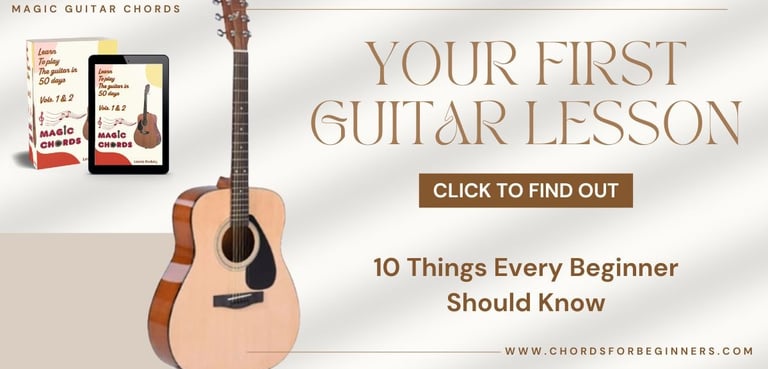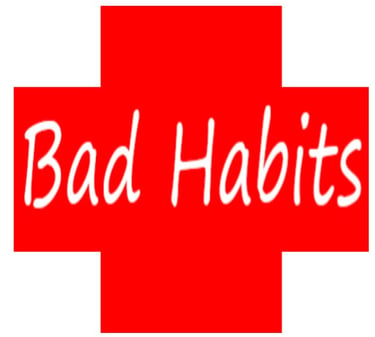
Your First Guitar Lesson: 10 Things Every Beginner Should Know
In your first guitar lesson we offer essential tips and advice to help newcomers navigate challenges, develop foundational skills, build confidence and achieve success.
magicchords.com


Learning guitar is an exciting journey, but starting out can feel overwhelming. To set yourself up for success, there are a few key things every beginner guitarist should know.
🎸 10 Things Every Beginner Should Know:
From mastering basic chords and strumming patterns to understanding proper technique and equipment care, these essentials provide a strong foundation for your musical growth. Whether you're picking up the guitar for fun or aspiring to perform, knowing these 10 tips will make your learning process smoother, more enjoyable, and highly rewarding.
1. Proper Posture and Holding the Guitar
Proper posture and holding the guitar correctly are essential for beginners to play comfortably and avoid strain. Sit on a sturdy chair, keeping your back straight but relaxed. Rest the guitar on your dominant leg for an acoustic guitar, or on your non-dominant leg if using a strap for electric guitars. The guitar's body should rest against your chest, with the neck angled slightly upward. Keep your fretting hand relaxed, forming a natural curve, and avoid gripping the neck too tightly. Place your strumming arm over the guitar body lightly. Good posture ensures ease of movement and better control while playing.


2. How to Tune the Guitar
Learning to tune a guitar is an essential skill for every beginner, as it ensures your instrument always sounds its best. Start by understanding standard tuning: E A D G B E (from the thickest to the thinnest string). Using a clip-on electronic tuner is the easiest method. Attach it to the headstock, pluck a string, and adjust the tuning peg until the tuner indicates the correct pitch. Alternatively, you can use a piano, tuning app, or another instrument as a reference tone.


Always tune slowly to avoid over-tightening and potentially breaking a string. Check the tuning regularly, especially if the guitar has new strings or is exposed to temperature changes. Regular tuning practice will make it second nature and improve your overall playing experience.
3. Things Every Beginner Should Know: Open Chords
Learning basic open chords is one of the most important steps for beginner guitarists. These chords form the foundation for countless songs and help you build finger strength, flexibility, and coordination. Start with the most common chords: G, C, D, Em, Am, and A. These are often used in simple and popular songs, making them ideal for practice.


When learning a chord, focus on finger placement. Use the tips of your fingers to press the strings just behind the frets, ensuring a clear, buzz-free sound. Keep your fingers arched to avoid muting adjacent strings. Practice transitioning between two chords at a time, such as G to C or D to Em, using a steady rhythm to build muscle memory. It’s also essential to play slowly at first. Speed will naturally improve as your comfort grows. Don’t get discouraged if it feels challenging; consistent practice is key. Playing along with easy songs is a fun way to reinforce what you’ve learned.
If you are truly determined and want to learn quickly, download the following book:
Mastering basic open chords will unlock endless possibilities on the guitar, allowing you to play a wide variety of music while building confidence in your skills.
4. Your First Guitar Lesson: Simple Strumming Patterns


Simple strumming patterns are essential for beginner guitarists to develop rhythm and timing. Start with a basic downstroke pattern, strumming all strings evenly in a steady beat. Once comfortable, try alternating downstrokes and upstrokes (e.g., down-up-down-up), focusing on maintaining a consistent rhythm.
Practice with a metronome or along to a slow song to build timing. A common beginner pattern is down-down-up-up-down-up, which works well for many songs. Keep your strumming hand relaxed, using your wrist for smooth motion rather than your arm.
Experiment with muting strings or emphasizing certain strokes to add variety. Mastering these basics lays the foundation for dynamic, expressive guitar playing.
You didn’t come this far to stop: How to tune your guitar easily? Easy Steps for a Perfect Sound!
5. Things Every Beginner Should Know: How to Read Chord Diagrams and Tabs
Learning to read chord diagrams and tabs is crucial for beginner guitarists, as they are essential tools for learning songs. Chord diagrams represent the guitar’s neck. The vertical lines are the strings, and the horizontal lines are the frets. Circles or dots indicate where to place your fingers, with numbers (1-4) showing which finger to use. An “X” above a string means it’s muted, while an “O” means it’s played open.


Tabs (tablature) use six lines representing the strings, with numbers indicating the frets to press. A “0” means an open string, and numbers show specific notes. Read tabs from left to right, playing notes or chords sequentially. Practice reading diagrams and tabs while playing simple songs to reinforce your understanding and improve fluency.
6. Your First Guitar Lesson: Finger Placement and Technique
Mastering finger placement and technique is essential for beginners learning to play the guitar. Proper hand positioning ensures comfort, accuracy, and prevents injury during practice.


Sit upright and hold the guitar at a comfortable angle. Ensure your fretting hand is relaxed and your thumb rests behind the neck for support, not pressing too hard. Place your fingertips close to the frets, but not directly on them, to produce clear, buzz-free notes. Keep your fingers curved to avoid muting adjacent strings. Apply enough pressure to produce a clean sound without straining your fingers. Start with simple scales and open chords. Repeat transitions between chords to build muscle memory. Exercises like the "spider walk" help train each finger to move independently, enhancing agility.
Patience and consistent practice are key to mastering guitar technique. With time, proper finger placement will feel natural, setting the foundation for more advanced skills.
Try this song for exemple: Simple Chords for New Guitarists: 4 Non Blondes – What’s Up?
7. Things Every Beginner Should Know: Patience and Consistent Practice
Learning the guitar requires patience and consistent practice. Progress may feel slow at first, but persistence is key to improvement. Set realistic goals and break your practice sessions into manageable chunks, focusing on specific skills like chord transitions, strumming patterns, or scales.


Practice regularly, even for just 10–15 minutes a day, rather than sporadically for long hours. Repetition builds muscle memory, while gradual challenges keep you motivated. Celebrate small achievements to stay positive and inspired. Remember, mistakes are part of learning. Approach each session with patience, and over time, your dedication will transform into noticeable progress and growing confidence.
8. Your First Guitar Lesson: Basic Songs to Play


Starting with simple songs is a great way for beginners to build confidence and enjoy playing the guitar. Choose songs with basic chord progressions, like G, C, D, and Em, which are easy to learn and widely used in popular music. Classics like "What’s Up" by 4 Non Blondes or "The Lion Sleeps Tonight" by The Tokens are perfect for beginners.
Focus on slow strumming patterns to match the rhythm, and practice switching between chords smoothly. As you gain confidence, try songs with slightly more complex patterns. Playing familiar tunes makes practice fun and rewarding, keeping you motivated.
9. Your First Guitar Lesson: 10 Things Every Beginner Should Know - Proper String Care
Caring for your guitar strings is essential for maintaining sound quality and extending their lifespan. After each practice session, wipe your strings with a clean, dry cloth to remove sweat and oils that can cause corrosion. Use string cleaner or conditioner occasionally for deeper maintenance.
Always wash your hands before playing to minimize dirt buildup. Check for signs of wear, such as discoloration or fraying, and replace old strings promptly to maintain consistent tone. Store your guitar in a case or stand to protect it from dust and humidity, ensuring your strings remain in excellent condition.


10. Things Every Beginner Should Know: Avoiding Bad Habits
Starting your guitar journey with good habits is essential to avoid setbacks and ensure steady progress. Here are some common mistakes beginners should avoid:
Incorrect Posture: Sit upright with a relaxed grip on the guitar to prevent discomfort and long-term strain. Avoid slouching or awkward hand positioning.
Improper Finger Placement: Use your fingertips, not the pads, and press close to the frets for clean notes. Practice precise finger placement early on.
Skipping Warm-Ups: Warm up your fingers with simple exercises or scales to improve flexibility and prevent injury.


Rushing: Focus on accuracy before speed. Trying to play fast without mastering fundamentals can lead to sloppy technique.
Neglecting a Practice Routine: Consistency is key. Short, regular sessions are more effective than infrequent, lengthy practices.
Ignoring Tuning: Always tune your guitar before playing to develop a good ear for sound.






